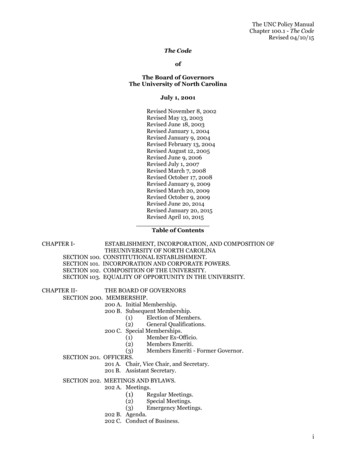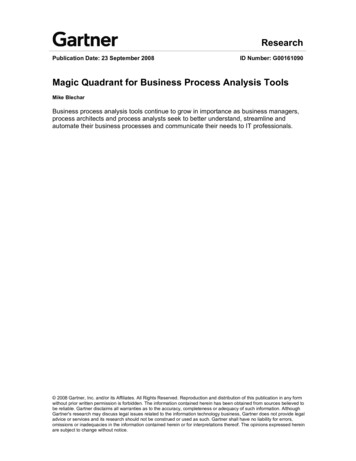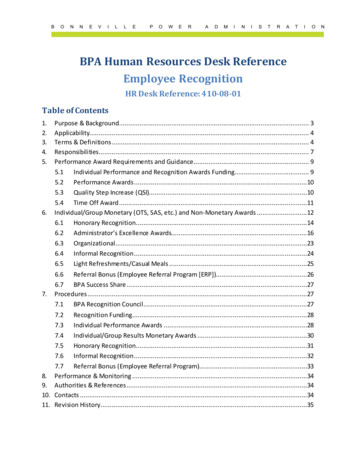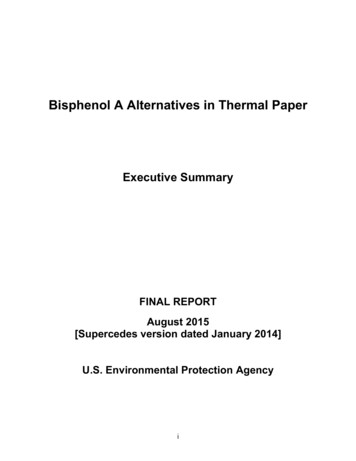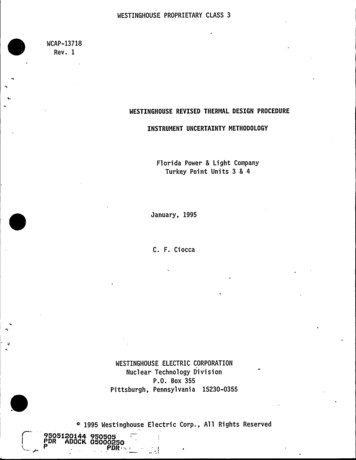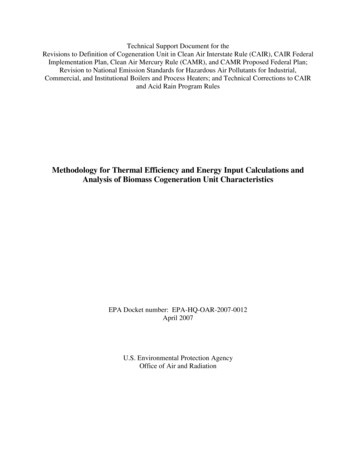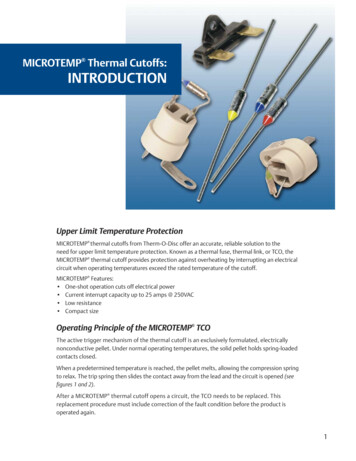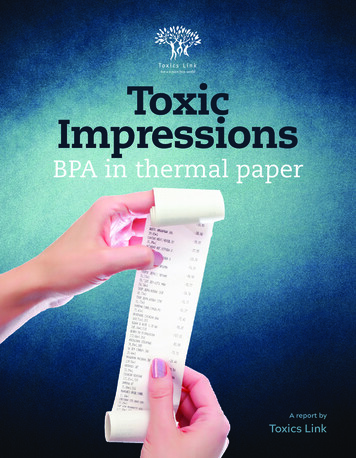
Transcription
ToxicImpressionsBPA in thermal paperA report byToxics Link1
About Toxics LinkToxics Link is an Indian environmental research and advocacy organization set up in 1996, engagedin disseminating information to help strengthen the campaign against toxics pollution, providecleaner alternatives and bring together groups and people affected by this problem.Toxics Link’s Mission Statement - “Working together for environmental justice and freedom fromtoxics. We have taken upon ourselves to collect and share both information about the sources andthe dangers of poisons in our environment and bodies, and information about clean and sustainablealternatives for India and the rest of the world.”Toxics Link has a unique expertise in areas of hazardous, medical and municipal wastes,international waste trade, and the emerging issues of pesticides, Persistent Organic Pollutants(POPs), hazardous heavy metal contamination etc. from the environment and public health point ofview. We have successfully implemented various best practices and have brought in policy changesin the afore mentioned areas apart from creating awareness among several stakeholder groups.Copyright Toxics Link, 2017All rights reservedFOR FURTHER INFORMATION:Toxics LinkH-2, Jungpura ExtensionNew Delhi – 110014Phone: 91-(11)-24328006, 24320711Fax: 91-(11)-24321747Email: info@toxicslink.orgWeb: www.toxicslink.orgResearch Team: Dr. Prashant Rajankar, Piyush Mohapatra and Kritika Mathur2BPAin Thermal Paper
ToxicImpressionsBPA in thermal paperA report byToxics Link
AcknowledgmentWe take this opportunity to thank all those who were instrumental in shaping up this report.We are thankful to the research team headed by Prof. Surya Pratap Singh, Department ofBiochemistry, Banaras Hindu University (BHU), Varanasi for his support in sample analysis.We also express our sincere gratitude to Swedish Society for Nature Conservation (SSNC) for theirsupport towards this study.We would also like to thank our fellow colleagues at Toxics Link who were helpful in completing thisreport. Their comments and suggestions have been critical in understanding the issue.iiBPAin Thermal Paper
AbbreviationsivBackgroundvIntroduction11.1 About BPA11.2 Health Impacts of BPA21.3 Thermal paper and mechanism of printing21.4 Advantages of thermal paper printing31.5 Market size of thermal paper4Literature Review: BPA in thermal paper52.1 Impacting human health and environment52.2 Regulation of BPA in thermal papers7Rationale of the Study93.1 Objectives93.2 Sampling and Methodology3.2.1 Sampling9103.2.2 Methodology for quantitative analysis of Bisphenol-A(Gas Chromatography method)103.3 Scope103.4 Standard preparation10Results and Discussion11Conclusion and Recommendations135.1 Regulation of BPA in thermal papers135.2 Suitable disposal of thermal papers135.3 Awareness Generation135.4 Alternatives145.5 Research Agenda14Bibliography15iii
AbbreviationsivADHDAttention-deficit/hyperactivity disorderBPABisphenol-ABISBureau of Indian Standardsμg/dayMicrogram per dayμg/gMicrogram per gramμg/LMicrogram per litreBPFBisphenol-FBPSBisphenol-Sbw/dayBody weight per dayECGsElectrocardiogramsECEuropean CommissionFDAFood and Drug AdministrationLC–MSLiquid chromatography–mass spectrometryBPAin Thermal Paper
BackgroundBisphenol – A (BPA) is a known Endocrine Disrupting Chemical (EDC) thatinterferes with the production, secretion, transport, action, functionand elimination of natural hormones of the human being. BPA can mimicour body’s own hormones in a way that could be hazardous for one’s ownhealth. Children are most susceptible to the health impacts caused due toBPA exposure. Globally, countries have initiated actions to phase out BPAfrom children’s products.Since BPA is a known toxic chemical, Toxics Link has initiated work on EDCsand has been working for its phase out in children products. In 2014, Toxicslink conducted a study on baby feeding bottles and found high content ofBPA and campaigned to phase out BPA from baby feeding bottles. Finally,the Bureau of Indian Standards (BIS) phased out BPA use in feeding bottlesas per IS 14625:2015.In continuation to this campaign, Toxics Link carried out another researchstudy on BPA presence in baby sippy cups and teethers. The use of BPAin sippy cups is not regulated in India. Toxics Link study led the Bureau ofIndian Standards to include sippy cups and other drinking accessories liketeats, cup, spout and straw intended for feeding infant milk substitutes inthe ambit of this regulation.However, the studies also found that BPA presence in other products canbe harmful to human health and environment. BPA is used in the thermalpaper receipt and is very loosely bound with it. So, Toxics Link has carriedthis study on BPA in thermal (receipt) paper to get an understanding onthe quantum of use of BPA in thermal paper and possible impacts on thehuman health and environmental hazards caused due to its exposure.This report also suggests the need of regulation of BPA in thermal paperin India and shifts to the alternatives to prevent the BPA exposure in theenvironment.v
viBPAin Thermal Paper
1.1About BPABisphenol-A (BPA) is used as a monomer in the production process ofpolycarbonate plastics for day-to-day consumer products (e.g. babyfeeding bottles, sippy cups, etc) and epoxy resin linings for food andbeverage containers and for polyacrylate dental materials.BPA is a well-known endocrine disrupting chemical. The issuesconcerning BPA is of global concern hence, as preventive measurecountries have initiated actions to phase out BPA from variousproducts considering its negative impact on human health.Toxics Link conducted several research studies on children productsincluding baby feeding bottles (2014), baby sippy cups (2016)and teethers (2016). Varied levels of BPA were detected in theseproducts. Surprisingly, the studies also revealed that BPA wasdetected in some products which were labeled as BPA free, 0 % BPAand safe for children. These studies helped catalyse governmentactions to notify the regulation to phase out BPA from childrenproducts including baby feeding bottles and sippy cups.However, BPA is also used in other daily use variants apart fromregular consumer products like teethers, baby food cans, sippy cups.BPA is one of the constituent chemical used in thermal paper, whichcan contaminate environment and is likely to affect human healthnegatively.Therefore,this study is carried out with a view to develop anunderstanding on BPA use in thermal papers used in India andrequirement of a regulation to prevent BPA exposure in theenvironment.1
1.2 Health Impacts of BPABPA is known for causing disruption in the endocrine system and there are studies whichsupports the claim that BPA can cause serious health hazards. [Toxics Link 2016] A study conducted on 244 mothers found that exposure to BPA before birth could affectthe behavior of girls’ at the age of 3, whose mother’s urine contained high levels of BPAduring pregnancy scored worse on tests of anxiety and hyperactivity Epidemiological studies found correlations between BPA exposure and heart diseases,liver toxicity and metabolic syndrome (diabetes, obesity) American Society for Reproductive Medicine (ASRM) found that women with the highestlevels of BPA in the blood are more likely to face misscarriage than women with the lowestlevels of BPA Researchers have reported that exposure to low doses of BPA lead to disruptive effectsin androgen or estrogen responsive tissues, within the immune system, thyroid, and thedeveloping nervous system Some studies in animals have confirmed that BPA can cause change in prostate growthand development, mammary gland organization, sexually dimorphic behavior, onset ofoestrus cyclicity, early puberty, body weight and genital malformations1.3Thermal paper and mechanism of printingThermal papers are widely used by retailers to print the sale receipts in various sectors likegrocery stores, gas stations and bank ATMs to ensure fast and accurate services. The thermalpaper is also used by ticketing agencies, lottery systems and other businesses, which requireFIGURE 1:Schematic diagram of thermal receipt paper identifying the thermal reactivelayer that contains BPA as a developer and a leuco dye, as well as stabilizers andbindersThermal headThermal Reactive LayerDeceloper (BPA) DyePrecoatBase paper2BPAin Thermal Paper
accurate and high-volume printouts. Specialized fields like healthcare sectors use high qualityimages produced by thermal printing for important and highly technical printouts for whichaccuracy is necessary, like electrocardiograms (ECGs), ultrasound printouts and prescriptionlabels.Figure 1 depicts a schematic diagram of thermal receipt paper identifying the thermalreactive layer that contains BPA as a developer and a leuco dye, as well as stabilizers andbinders.1The detailed mechanism of the composition of thermal paper and color development afterthermal reaction is presented in Figure 2.FIGURE 2: Mechanism of printingPaper surface coated with solid-state mixture of adye and a suitable matrix e.g. fluoran leuco dyeHeat abovemelting pointFluoran leuco dye reactions with Acid (Often BPA)It is a colored formThe changed form is then conserved in a metastablestate when the matrix solidifies back quicklyenough1.4Advantages of thermal paper printingThermal paper printers are much faster than other types of printers resulting in lesswaiting time at the checkout line. The images created are of superior quality and clearer incomparison to other types of printing thus making them an integral component to be usedeverywhere. They are used in all places ranging from hospitals, where accuracy of a printoutis critical to a local store, where itemized receipts through thermal printing help consumersto keep a better eye on their spending. The printers are also capable of printing high qualitybarcode scans directly on a receipt, making complex transactions like returns and exchangesmuch easier for customers, retailers’ preventing shoplifting and falsified receipts that can1Hormann AM, Vom Saal FS, Nagel SC, Stahlhut RW, Moyer CL, et al. (2014) Holding Thermal Receipt Paper andEating Food after Using Hand Sanitizer Results in High Serum Bioactive and Urine Total Levels of Bisphenol A(BPA). PLoS ONE 9(10): e110509. doi:10.1371/journal.pone.01105093
have a direct effect on its prices. Generally, thermal paper is coated with BPA which makes itextremely stable and heat-resistant. BPA is used in making coatings that gives thermal paperit’s unique properties which allows inkless printing.21.5Market size of thermal paperThe global thermal paper market size was estimated at 1,154.8 kilo tons in 2015 and is expectedto witness a substantial growth over the forecast period due to its extensive use in tags,labels, tickets and receipts. Its rising demand at point of sale (POS) terminals as an alternativeto cash registers in the hospitality, warehouse, retail, and laboratory sectors is expected tobe a favorable factor for its growth. POS was the largest application accounting for 81.9% ofglobal volume share in 2015. The rising number of retail outlets and supermarkets in China,India and Saudi Arabia are due to increasing urban population and supportive governmentpolicies to promote investments which are expected to remain a key driver for the industry inthe near future.3India is growing market for the thermal paper industries with the changing the economicdynamics of the country. In India the thermal papers are manufactured here at the same timelarge quantity of these papers is being imported. South Korea is one of the biggest importersof thermal papers to industry-analysis/thermal-paper-marketBPAin Thermal Paper
BPA in thermal papers2.1 Impact on human health andenvironmentBPA is commonly used due to its efficiency, availability and affordability. However, BPA a known endocrine disruptor is a cause ofconcern for the researchers’ worldwide and number of researchstudies have been initiated linking BPA from thermal papers and itsimpact on human health and environment.A study conducted by Shelley Ehrlich et al in Harvard Universityof Public Health in 2015 found that found increase in BPAconcentration in their urine after handling of receipts for 2 hrscontinuously without gloves but no any increase of BPA wasobserved while using the gloves.4A study done by Annette M. Hormann et. al., the University ofMissouri. 2014 concluded that the elevated levels of BPA wereobserved in the serum while holding the thermal paper. In theirexperiment, they have tried to establish linkages with BPAexposure effects and hand sanitizer. The study found that whena person holds thermal paper receipt immediately after using ahand sanitizer, there is high chance of release of BPA as a freechemical and absorb in to the body through the skin. The studyalso found that it was a combination of dermal and oral BPAabsorption that led to a rapid and dramatic average maximumincrease (Cmax) in unconjugated (bioactive) BPA of 7 ng/ml inserum and 20 mg total BPA/g creatinine in urine within 90 min.5BPAFREEReseach studies found “BPA free” labeledconsumer products sold in market alsoshowed presence of BPA,In 2013, researchers from Kannur University, Kerala, Indiaanalyzed thermal papers used at the local automated tellermachine counters of India for detecting presence of BPAand the capability of paper to produce estrogen to those45Shelley Ehrlich, Antonia M. Calafat, Olivier Humblet, Thomas Smith, and RussHauser, Handling of thermal receipts as a source of exposure to Bisphenol A,JAMA. 2014 February 26; 311(8): 859–860. doi:10.1001/jama.2013.283735Hormann AM, vom Saal FS, Nagel SC, Stahlhut RW, Moyer CL, et al. (2014)Holding Thermal Receipt Paper and Eating Food after Using Hand Sanitizer Resultsin High Serum Bioactive and Urine Total Levels of Bisphenol A (BPA). PLoS ONE9(10): e110509. doi:10.1371/journal.pone.01105095
who have been exposed toBPA. The results of the studyindicate that these papers canproduce estrogen hormone“Touching the thermal paperafter using hand sanitizer isunsafe”like hormone-like effect onexperimental systems. Further,the research study also hasstated that as tons of such receipts are being dumped into the environment, this canlead to the high amount of hormone disruptors are being deposited in the environment.Since BPA in thermal paper exists as free, un reacted molecule , there is the potential formobility and therefore human exposure during handling of the receipt paper. Further thestudy also proposes the remedial measures to remove the estrogenic properties of thethermal paper with the purified laccase from asocmycete fungi.6Tinne Geens et al., 2012, did an estimation of the levels of Bisphenol A thermal paperreceipts collected from Belgium and its exposure to human beings. In his study he foundthat out of the total 44 thermal paper samples, BPA was determined in 73 % of thetotal samples which had Concentrations between 0.9% and 2.1% (between 9 and 21 mgBPA/g paper), while remaining 27% of the samples had concentrations below 0.01% (0.1mg BPA/g paper). Further he studied on BPA from thermal paper and its impact on thepeople who are exposed occupationally to thermal paper and try to establish linkagesthat whether frequent contact with the thermal paper is associated with an increase inurinary BPA excretion.7 In this analysis, urine samples were collected from 90 cashierswho use the handle the BPA receipts and 44 control samples. BPA was detected in all thesamples. The median urinary total BPA concentration was found to be 3.54 μg/L (2.89 μg/gcreatinine) for controls and 8.92 μg/L (6.76 μg/g creatinine) for cashiers. Hence the studyconcluded that significant increase in urinary total BPA concentration was observed forcashiers handling thermal paper receipts daily.In another experiment carried out in France by Zalko D. et al., 2010, with viable skinmodels demonstrated extensive uptake and biotransformation of BPA following theabsorption in the skin. In his research paper, he has demonstrated that the trans dermalexposure is contributed significantly to BPA exposure in human, when direct contact withBPA (free monomer) occurs. Incidentally, thermal papers are important source of freeBPA.86786Divya L M, Prasanth G K, Sadasivan C, 2014, Elimination of estrogenic activity of thermal paper using laccase fromTrichoderma sp NFCCI-2745, Applied biochem- istry and biotechnology, 2013; 169 (4) doi:10.1007/s12010-0120016-yTinne Geens, Leo Goeyens, Kurunthachalam Kannan, Hugo Neels, Adrian Covaci. Levels of bisphenol-A in thermalpaper receipts from Belgium and estimation of human exposure. Science of the Total Environment, 2012, 435 436;30–33Zalko, D., et al. Viable skin efficiently absorbs and metabolizes bisphenol A. Chemosphere (2010), doi:10.1016/ j.chemosphere.2010.09.058 (article in press)BPAin Thermal Paper
2.2Regulation of BPA in thermal papersGlobally efforts are being made to phase out or restrict the use of BPA in thermal papersconsidering the precautionary principle.TABLE 1Regulation of BPA in thermal papers91011121314151617CountriesStatus of use of BPA in thermal paperJapanBanned BPA since 20019BelgiumBanned BPA in thermal papers in 201110Suffolk CountyLegislature, New YorkLaw to ban BPA use in thermal papers starting from 201311Illinois & New YorkBan use of BPA containing receipt paper in 2012 legislativesessions12Connecticut (USA)Prohibited BPA use in thermal papers from either 2013 or 2015depending upon the availability of commercial alternatives before30 June 201313France, Denmark,Sweden, Mariland,Washington, Vemount,Canada, Minnesota,MaschettetusBanned BPA in thermal papers14European UnionBPA concentration in thermal paper to be reduced to less than orequal to 0.02% weight (200 ppm) before 2 January 202015South KoreaDevelopments in restricting BPA use in till receipts16TaiwanDevelopments in restricting BPA use in es/production/files/2015-09/documents/bpa ch2.pdfhttps://en.wikipedia.org/wiki/Bisphenol fornia-proposition-65-recent-updatesBarraza, L. (2013). A new approach for regulating bisphenol A for the protection of the public’s health. The Journal ofLaw, Medicine & Ethics, 41(s1), 286548/Carcinogen-found.htm7
ALTERNATE SOLUTIONSThere can be non-phenol alternatives for BPA use in thermal papers. Some of them arelisted below: Pergafast (evaluated as EPA alternatives assessment) Urea urethane (evaluated as EPA alternatives assessment) Ascorbic acidHowever, there are still gaps in the evaluation of their health and environmental impacts.Technical alternatives to prevent BPA exposure through thermal papers include:Matrix printingInkjet printsThermal transfer printingUse of E-tickets and payments using mobile can also be adopted to minimize the exposure8BPAin Thermal Paper
of the StudyBisphenol-A is a well-known Endocrine Disrupting Chemical (EDC)that can affect health of human beings particularly children whoare most vulnerable to its exposure. With the growing quantum useof thermal papers in day-to-day life and no system for collectionof used slips, in most of the cases these thermal papers aredispersed into the surrounding environment, contaminating theecosystem as well as the food chain. Although, many countries haveinitiated actions to phase out or restrict BPA from thermal papershowever, there is no information and discussion being initiatedon the possible impact of the chemical from thermal papers inIndia. Therefore, this study is first of its kind in Indian contextlargely focusing on analysis of presence of BPA used in thermalpapers in India. Further, the study is aimed to catalyze discussionon the management of BPA in thermal papers at the upstream anddownstream level.3.1ObjectivesThe present study has the following objectives: To detect the presence of Bisphenol-A(BPA) in thermal papers used indifferent stores in Indian market To highlight the need of BPA regulationfor thermal papers in India3.2Sampling and MethodologyChemicals required during experimental analysis of BPA in thermalpapers1.BPA from Sigma-Aldrich2.HPLC grade water3.Ethyl Acetate (HPLC grade)4.Methanol (HPLC grade)5.Acetonitrile (HPLC grade)9
3.2.1 SamplingIn this study, total twelve (12) samples of thermal papers were collected randomly fromdifferent markets in New Delhi. The samples collected included both known and local brandsof different manufacturers and suppliers. Out of twelve, two samples were printed withbank name (provided to the respective bank with their swipe machine). All the samples werecollected in duplicate and sent to Department of Biotechnology, Banaras Hindu University,Varanasi for quantitative analysis of BPA.3.2.2 Methodology for quantitative analysis of Bisphenol-A(Gas Chromatography method)Twelve samples of thermal paper receipt were used in this study. 100 mg of each thermalpaper receipt were cut into small pieces and extracted for 60 minutes in 1 mL of pure waterat room temperature. After the extraction process, BPA quantity that passed into water wasanalyzed through High Performance Liquid Chromatography (HPLC). HPLC analysis was carriedout on a Agilent 1200 Series HPLC system equipped with a C18 column (100 x 2.1 mm, particlesize 2.7 μm) using a mobile phase composed of water/acetonitrile (60:40, v/v) at a flow rate of1 mL/min and column temperature at 30 C. Fluorescence excitation and emission wavelengthfor BPA detection was 225 nm and 310 nm respectively. The chromatograms were processedusing software.3.3ScopeThis test method covers determination of Bisphenol-A (BPA) using gas chromatography anddetecting using mass selective detection.3.4Standard preparationBPA standard solution was prepared by dissolving 1 mg of AR-grade BPA in 1 ml of Acetonitrile.10BPAin Thermal Paper
& Discussion Bisphenol-A was detected in all the collected samples withvaried levels Concentration of BPA is found to be between 0.03% (300 ppm)and 0.66 % (6600 ppm) in thermal papers Maximum concentration of BPA in thermal paper was found tobe 0.66 % (6600 ppm) There is no established correlation between the presence ofhigh amount of BPA and its impact on the printingTABLE 2 Concentration of BPA in thermal papersSamplingIDDescription% BPA Conc(mg/100mg paper)PPMTL TP-1Small sized roll used forslip generated in ATM,Jungpura0.1671670TL TP -2Small sized roll used forslip generated in ATM,Bhogal0.3723720TL TP - 3Small sized roll used forslip generated in ATM,Lajpat Nagar0.3173170TL TP - 4Big size, used forgeneration of bill in stores,grocery shops etc, Bhogal0.035350TL TP - 5Big size, used forgeneration of bill in stores,grocery shops etc, NehruPlace0.03300TL TP - 6Big size, used forgeneration of bill in stores,grocery shops etc, NehruPlace0.097970TL TP - 7Big size, used forgeneration of bill in stores,grocery shops etc, Kotla0.666600TL TP - 8Medium sized roll, MalviyaNagar0.575700TL TP - 9Big size rolls - AmazonOnline0.5858000.1591590TL TP -10 For printing bills at theoutlet, Jungpura ExtensionTL-TP-11Big size rolls - AmazonOnline0.6096090TL-TP-12Big size rolls, Bhogal0.04848011
12BPAin Thermal PaperTLTP 12TLTP 11TLTP 1048060905800TLTP 9057006000TLTP 866007000159097030031708000TLTP 7TLTP 6TLTP 53501000TLTP 4200037204000TLTP 3300016705000TLTP 2TLTP 1FIGURE 3Concentration of Bisphenol A in thermal papers (ppm)
and RecommendationsBPA generally binds very loosely with the thermal papers.Nevertheless in India there is no downstream managementsystem in place for the used thermal papers. Hence there is everypossibility that BPA from the thermal paper will leach into theenvironment and contaminate the ecosystems. In this context, thestudy proposes the following recommendations.Toxics Link would like to propose the following recommendations inthe context of the present study.5.1Regulation of BPA in thermal papersThere are countries across the globe taking actions to either phaseout or reduce the limits of BPA content in thermal paper. Therefore,as a precautionary approach, India should also regulate BPA inthermal papers to minimize the risk and impact on human healthand environment.5.2Suitable disposal of thermal papersThe research study indicates high content of BPA in thermal papersin India. There is no proper disposal system in place for thesethermal papers and they finally enter into the ecosystem. Further,there is a possibility that these BPA containing thermal papersmay get recycled and contaminate the other products. Therefore,suitable guidelines should be developed considering the overallmanagement of these papers.5.3Awareness GenerationStakeholders awareness is another key factor to minimize the risksassociated with BPA. The relevant agencies should step in to createawareness among the stakeholders to prevent the possible impactof BPA from thermal papers. Some of the suggested measures are Avoid taking receipts unless one really need them as veryoften these receipts end up in the trash and contaminating theenvironment Go for on-line receipts as far as possible Wash your hands after touching the thermal receipts It is advisable to use gloves to minimize the risks while handlingBPA coated receipts. The govt can issue guidelines in thisregard considering the public health13
5.4AlternativesIn India, BPA free thermal papers are used widely and so it is possible to shift to thealternatives for producing thermal papers considering their negative on impact human healthand environment.5.5Research AgendaThere are only few research studies on possible impact of BPA in Indian context. Therefore,more research studies may be developed on its impact on human health and environment.14BPAin Thermal Paper
Hormann AM, vom Saal FS, Nagel SC, Stahlhut RW, Moyer CL, etal. (2014) Holding Thermal Receipt Paper and Eating Food afterUsing Hand Sanitizer Results in High Serum Bioactive and UrineTotal Levels of Bisphenol A (BPA). PLoS ONE 9(10): e110509.doi:10.1371/journal.pone.0110509 al-paper /thermalpaper-market Shelley Ehrlich, Antonia M. Calafat, Olivier Humblet, ThomasSmith, and Russ Hauser, Handling of thermal receipts as asource of exposure to Bisphenol A, JAMA. 2014 February 26;311(8): 859–860. doi:10.1001/jama.2013.283735 Hormann AM, vom Saal FS, Nagel SC, Stahlhut RW, Moyer CL, etal. (2014) Holding Thermal Receipt Paper and Eating Food afterUsing Hand Sanitizer Results in High Serum Bioactive and UrineTotal Levels of Bisphenol A (BPA). PLoS ONE 9(10): e110509.doi:10.1371/journal.pone.0110509 Divya L M, Prasanth G K, Sadasivan C, 2014, Elimination ofestrogenic activity of thermal paper using laccase fromTrichoderma sp NFCCI-2745, Applied biochem- istry andbiotechnology, 2013; 169 (4) doi:10.1007/s12010-012-0016-y Tinne Geens, Leo Goeyens, Kurunthachalam Kannan, HugoNeels, Adrian Covaci. Levels of bisphenol-A in thermal paperreceipts from Belgium and estimation of human exposure.Science of the Total Environment, 2012, 435 436; 30–33 Zalko, D., et al. Viable skin efficiently absorbs and metabolizesbisphenol A. Chemosphere (2010), doi:10.1016/ j.chemosphere.2010.09.058 (article in press) /documents/bpa ch2.pdf https://en.wikipedia.org/wiki/Bisphenol A#Regulation p2s10-13.pdf ent-updates Barraza, L. (2013). A new approach for regulating bisphenol Afor the protection of the public’s health. The Journal of Law,Medicine & Ethics, 41(s1), 9-1215
als- 4656089-nor.html 07-f1b4-edc6-80ef2e5cd781 all-for-bpa-ban-in-till-receipts al-news/2011/01/06/286548/Carcinogen-found.htm Toxics Link df Toxics Link 2016 (a) http://toxicslink.org/docs/BPA-Sippy-Cups-2016.pdf Toxics Lin 2016 (b) http://toxicslink.org/docs//Teether%202016.pdf “BPA Exposure in Pregnancy May Affect Behavior in Girls – TIME.com”. Time. 24 October2011. Newbold RR, Padilla-Banks E, Jefferson WN, 2009 a.Environmental estrogens and obesity.Mol Cell Endocrinol, 304(1-2): 84-9. http://www.asrm.org/Effects of BPA and Phthalates on Conception and Pregnancy/ Richter CA, Taylor, Ruhlen RL, Welshons WV, vomSaal FS, 2007. Estradiol and BisphenolA stimulate androgen receptor and estrogen receptor gene expression in fetal mouseprostate mesenchyme cells. Environ Health Persp, 115 (6). Vandenberg LN, Chahoud I, Heindel JJ, Padmanabhan V, Paumgartten FJR, SchoenfelderG,2010. Urinary, circulating, and tissue biomonitoring studies indicate widespreadexposure to Bisphenol A. Environ Health Persp, 118 (8). Richter C, Birnbaum LS, Farabollini F, Newbold RR, Rubin BS, Talsness CE, VandenberghJG, Walser-Kuntz DR, vomSaal FS, 2007. In vivo effects of Bisphenol A in laboratory rodentstudies. Reprod Toxicol, 24: 199–224. Wetherill YB,
paper is also used by ticketing agencies, lottery systems and other businesses, which require Thermal head Thermal Reactive Layer Deceloper (BPA) Dye Precoat Base paper FIGURE 1: Schematic diagram of thermal receipt paper identifying the thermal reactive layer that contains BPA as a developer and a leuco dye, as well as stabilizers and binders
